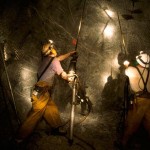Idaho Miners are in High Demand, Despite Lucky Friday Closure

Courtesy of Hecla Mining
Lucky Friday Mine workers in Mullan, Idaho are valued for their skill at "jackleg" mining, using hand-held equipment seen here.
They say the days when you could go from high school to a high-paying, blue collar job are long gone. But there are places in the Northwest where those days still exist — that is, if you’re willing to work a mile underground.
For gold and silver miners, it looks like boom times right now. Rising salaries, more job opportunities. Even a recent layoff in north Idaho doesn’t look like other layoffs.
Idaho Miners are in High Demand, Despite Lucky Friday Closure
Don Kotschevar teaches at the tiny high school in the small north Idaho town of Mullan. He’s the assistant principal/ basketball coach/ shop teacher.
But lately Kotschevar has been questioning his career path. His students are parlaying the skills he teaches them in this industrial mechanics class into mining jobs.
“Some of them? In the first six, eight months their salaries absolutely crush mine,” Kotschevar says.
Kotschevar has taught here for 24 years now and has connections at the local mine. So, he’s come up with a plan.
“You know I’ve got nine more years so I can get my retirement here and then when I retire I’ll go see if they’ll hire me,” he says. “Hopefully I won’t be too old.”
“So your retirement plan is to go work at a mine,” I ask.
“Well, yeah, I’ve been in teaching,” he says with a laugh. I need to have a retirement plan!”
Joking aside, the price of silver suddenly makes that plan viable. Mining companies are grasping for workers -– snatching up high school students as soon as they’re old enough.
One of those who’s been courted by local mines is Kotschevar’s son, Hunter. He’s in this shop class too -– it is a small school.
But Hunter Kotschevar has a different take from his dad’s.
“Crew bosses have said they can get me jobs for like the summer when I turn 18, but I don’t want to risk it. The cave-ins and everything kind of scared me.”
And there’s the flip side. Mining salaries can near six figures, but that compensation comes with hazards. Just a mile from this high school is the Lucky Friday Mine -– a silver mine that last year saw a series of tragic accidents. Not long after I spoke to Don and Hunter Kotschevar, the company that owns the Lucky Friday announced it would have to shut down for a year to comply with a federal safety order.
The closure is expected to be a major blow to north Idaho’s economy. But the 250 or so laid off workers -– they have their pick of jobs, if they’re willing to relocate. So says Sara Lamson with the Idaho Department of Labor.
“I’m surprised,” she says. “The calls are coming in and if they’re qualified and having mining experience, they definitely can get work.”

Jessica Robinson / Northwest News Network
A miner fills out an application for Newmont Mining, one of several mining companies holding frequent job fairs in Idaho's Silver Valley.
Denver-based Newmont Mining was one of three mining companies holding recruitment fairs on the same day in Idaho’s Silver Valley. Two were at the same hotel. All of them were vying for laid off Lucky Friday workers.
“We’ve had quite a few people coming through to talk to us and we’re interested in talking to as many more as possible,” says Newmont Mining Corporation’s Director for Talent Acquisition Nick Tompkins.
Numbers from the U.S. Bureau of Labor Statistics show metal mining has enjoyed a steady employment growth during four of the last five years –- often around 10 percent. And remember, this is during a time period when most economic charts point downhill.
“It’s been a growth period for us,” Tompkins says. “Instead of lowering bonuses, upping insurance costs, reducing benefits to our employees, we’ve done exactly the opposite on every one of those.”
Just recently, President Obama’s jobs council report identified mining as a key area for U.S. economic growth. Tompkins says entry-level mine jobs can pay $50,000 a year — even for someone right out of high school.
“A 19-year-old kid –- that’s a lot of money,” says Brandon Farmin. He took a different route than Hunter Kotschevar, the high school student we met earlier. Farmin graduated from Kellogg High School last spring and now he’s a miner at the nearby Galena Mine.
“Everybody thinks you’re going to be claustrophobic down there and it’s really not that bad,” he says.
Farmin has cuts on his arms and a few blacked fingernails from work underground. He’s aware of the inherent dangers.
“Everything down there is a lot bigger. Nothing gives down there. The only thing that’s going to give is your body.”
Farmin made a deal with his grandmother: after a few years in the mine, he’ll go to college. But that may be a hard sell. Farmin is just bought himself a snowmobile. Meanwhile he says his friends come home from college broke.
“Askin’ mom and dad for money and stuff. That sucks. I’d hate that,” Farmin says. “And then a lot of them keep asking me how much I make. They’ll tell me how much they’re going to be making and I’m like yeah, you’re going to have a ways to go to catch up with me.”
Farmin says he’d like to make $100,000 … by the time he’s 21. That may depend on a couple of things: some hard days underground, and the price of silver staying high.
Jessica Robinson is a correspondent with the Northwest News Network, one of StateImpact Idaho’s partners.

